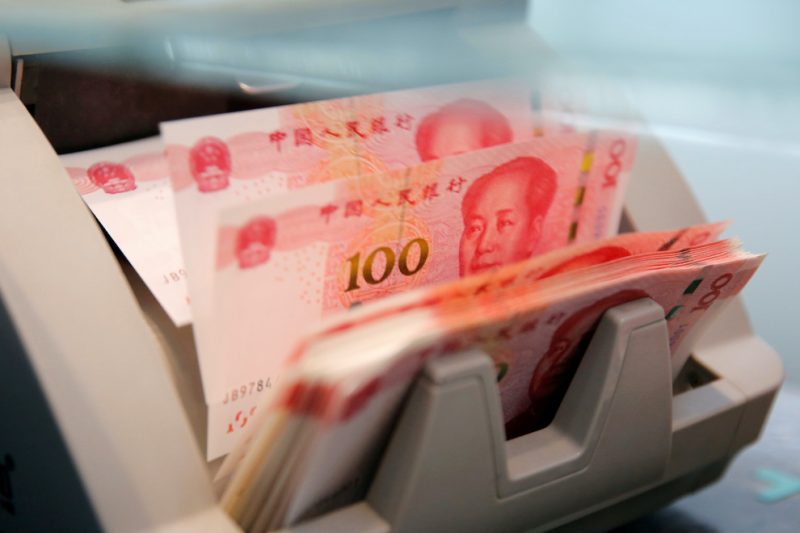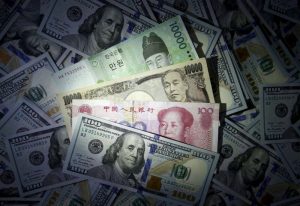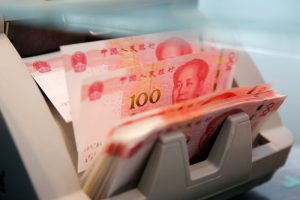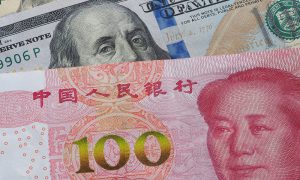The Chinese yuan slipped to an 18-month low on Monday as the dollar hit a two-decade high amid concern about the global economy, rising interest rates and the economic slowdown in China.
Investor uncertainty has buoyed the dollar because of surging inflation, war in Ukraine and China’s dogged insistence that Covid lockdowns be retained in Shanghai, Beijing and many other cities to protect its elderly population.
“Moves in US interest rates are not the only dollar support,” strategists at NatWest Markets said in a note.
“Downside risks to global growth stemming from Ukraine and China are more pressing for Europe and Asia relative to the US, creating an air of 2018-style dollar exceptionalism.”
The greenback made a 22-month high on the growth-sensitive New Zealand dollar and rose 1% to a three-month high against the Australian dollar as Asia’s stockmarkets tumbled. It rose 0.3% to its highest since 2019 on the Swiss franc.
ALSO READ: China’s Yuan Heads For Biggest-Ever Monthly Drop – FT
China Trade Flat
In China trade data showed imports flatlined in April and exports rose 3.9% – a little better than expected and enough to hold the Australian dollar at $0.7006 and off January’s low of $0.6967.
However the yuan was dragged to a fresh 18-month low of 6.7110 per dollar as lockdowns in Shanghai were tightened. Traders see the fallout from the inevitable drag on China’s economy raking across the region.
Prior to market opening, the People’s Bank of China (PBOC) set the yuan midpoint rate at 6.6899 per dollar, 567 pips or 0.85% weaker than the previous fix 6.6332, the weakest since November 3, 2020.
Similar to last week, the official guidance came in firmer than market projections. Traders and analysts took that as a sign the authorities want to slow the currency’s descent.
In the spot market, the onshore spot yuan fell below the psychologically-important 6.7 per dollar to a low of 6.7110 before changing hands at 6.6936 as of 0202 GMT, 285 pips weaker than the previous late session close.
Its offshore counterpart traded at 6.7337 per dollar.
Regional Currencies Dip
Meanwhile, the kiwi fell 0.9% to $0.6346 and the US dollar made multi-year highs on the trade-sensitive Taiwan dollar, South Korean won, Singapore dollar and Malaysian ringgit. It hit its highest in nine months against the Indonesian rupiah.
The yield on benchmark 10-year US government bonds has climbed a staggering 163 basis points this year and taken the dollar with it.
The dollar index is up nearly 9% for the year and gained for a fifth week in a row last week. It equalled Friday’s near 20-year high of 104.070 during the jittery Asia session.
Zero-Covid Policy
“The strength of the US dollar and China’s Covid-19 policy and associated implementations were and likely continue to be the main themes affecting CNY and other Asian currencies in near term,” Li Lin, head of global markets research for Asia at MUFG Bank, said.
Li cut her forecast for China’s full-year GDP growth to 4.3% from 5.2% previously, attributing the revision to China’s reaffirmation of its zero-Covid policy last week and continued stringent virus containment measures taken by local governments.
Shanghai authorities have tightened city-wide lockdown measures they imposed more than a month ago, prolonging into late May an ordeal that the capital Beijing wants to avoid by turning mass testing into an almost daily routine.
Ukraine War Declaration?
Speculation that Russian President Vladimir Putin might declare war on Ukraine in order to call up reserves during his speech at “Victory Day” celebrations also hurt market sentiment.
Putin has so far characterised Russia’s actions in Ukraine as a “special military operation”, not a war, or an invasion.
The US Federal Reserve hiked its benchmark funds rate 50 basis points (bps) last week and strong jobs data has reinforced bets on further big hikes, with inflation figures due on Wednesday in focus as next risk of an upside surprise.
Futures markets are pricing a 75% chance of a 75 bp rate rise at the Fed’s next meeting in June and more than 200 bps of tightening by year’s end.
“Risks around US CPI feel binary; a moderation from 8.5%would be mildly comforting, but a lift would doubtless revive expectations for 75 bp Fed hikes, and probably give the dollar a boost,” ANZ Bank analysts said.
“The idea that synchronised global tightening might proceed gently now feels like a forgotten dream.”
Cryptocurrencies have been battered in the rush from risky assets and bitcoin was nursing weekend losses and near its lowest levels of the year at $33,780 while ether, which fell 4% on Sunday, was at $2,470.
- Reuters with additional editing by Jim Pollard and Sean OMeara
ALSO READ:
Chinese Yuan Slips to One-Year Lows, Extending Losses
Chinese yuan plunges in March as foreign exchange reserves fall
Banks Forecast Weaker Yuan as Drive for Dollars Grows























